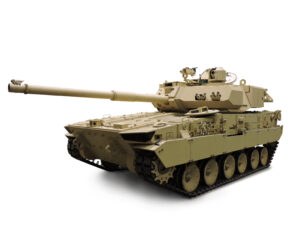General Dynamics Land Systems [GD] has won the Army’s Mobile Protected Firepower program, receiving a $1.14 billion contract covering delivery of up to 96 vehicles under low-rate initial production.
GDLS beat out BAE Systems for the MPF award, which begins with an initial order for 26 vehicles, with the Army’s top acquisition official calling this a “benchmark program” for the service’s modernization initiative and the push to move from successfully from rapid prototyping into production.

“The MPF program did exactly what the Army asked, which was to complete a competitive and accelerating rapid prototyping effort with multiple soldier touchpoints and test events,” Doug Bush, the Army’s acquisition executive, told reporters during a briefing on the contract award. “MPF shows the Army is committed to doing acquisition rapidly and using all the new approaches and new authorities we have to do modernization in a new way.”
In December 2018, the Army selected GDLS and BAE Systems to deliver 12 test platforms for the MPF rapid prototyping phase to test and evaluate offerings (Defense Daily, Dec. 17 2018).
GD’s offering combined a version of its latest M1 Abrams tank turret with a new, purpose-built chassis, while BAE Systems’ vehicle model for the MPF tank was based on the M8 Armored Gun System with a 105mm cannon.
Brig. Gen. Glenn Dean, program executive officer for ground combat systems, told reporters the Army then took the two companies’ prototypes and conducted developmental performance testing, limited live fire testing and a year-long soldier vehicle assessment, which then led into a limited user test and a live fire gunnery exercise.
Dean said now that the winner has been selected GDLS can bring in data collected from soldier feedback during prototyping to inform any design adjustments or refinements for the final production system.
The Army expects to receive the first production MPF within 19 months from now, according to Dean, with initial operational test and evaluation slated to begin in late fiscal year 2024.
The first unit equipped date for MPF is set for the fourth quarter of FY ‘25, with the Army’s overall acquisition objective remaining at 504 vehicles.
Army officials declined to comment on the potential that BAE Systems was eliminated from the competition several months prior to the contract award, as reported by Janes Defense, with Dean stating that the MPF process “achieved everything we were intending to.”
“We can’t go into the specifics of the source selection at this time. We can confirm that we had two bids submitted at the start of the source selection process and we will outbrief two vendors in the next 10 days. And once the outbrief has been completed with the vendors, we may be able to share what limited information we can,” Dean said.
Bush added he was also “very satisfied” with the course of the MPF competition.
“I think it’s great the Army got real prototypes in significant numbers, all of which went through thorough evaluation and testing, from two different vendors. I think that achieves the goal of competition to make sure we get the benefits that we want, both for performance and lower cost,” Bush told reporters.
Dean said the potential total value for the MPF program in terms of research and development and into procurement is roughly $6 billion and the total lifecycle cost estimate is for around $17 billion.